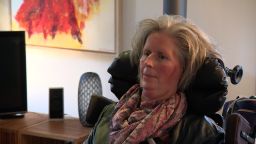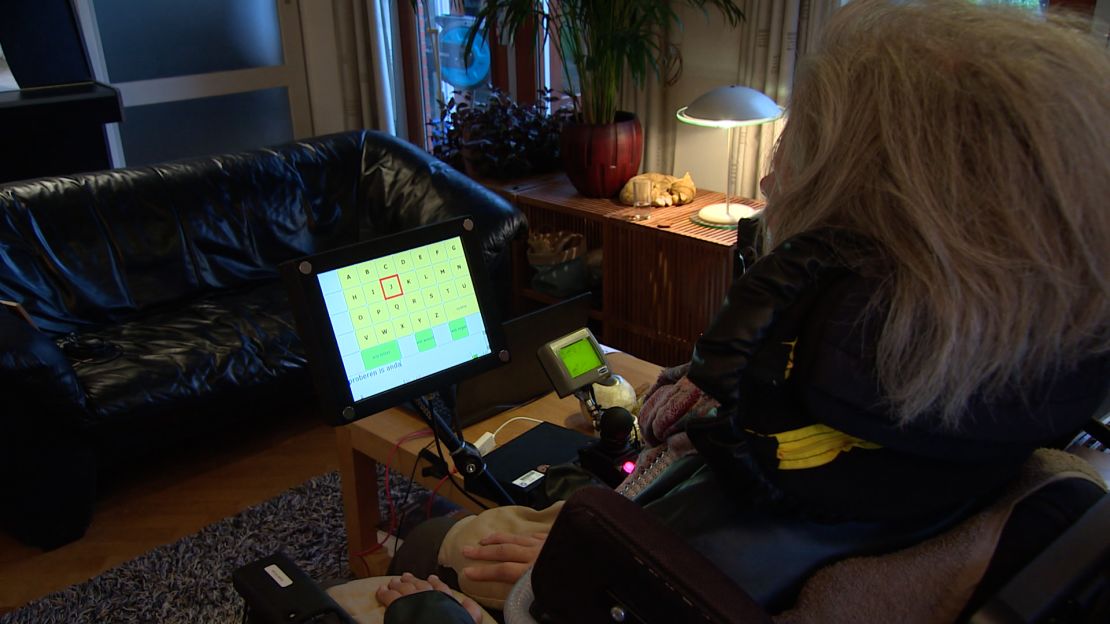Story highlights
A woman with ALS is now able to communicate with her family from any location
"We wanted to give these patients back their dignity," researcher says
In 2008, mother of three Hanneke de Bruijne was diagnosed with amyotrophic lateral sclerosis (ALS), also known as Lou Gehrig’s disease.
Over the next eight years, her life would change significantly as the nerves controlling her bodily movements degenerated. She would lose the ability to move her legs, arms, fingers and eventually even her face, leaving her locked inside her body, barely able to communicate with those around her. Breathing would require a mechanical ventilator.
But in 2015, she received a brain implant that would change her life, bringing back the ability to communicate wherever she was in the world.
“The implant gives me freedom, independence and safety,” de Bruijne wrote in an email composed on a tablet linked to her implant. “It enables me to enjoy my garden and going outdoors in nature.”
Until recently, de Bruijne’s main mode of communication had been through blinking or the use of an eye-tracking device to signal what she was thinking or wanted to say, but eye trackers are limited by a need for adequate lighting to enable eye movements to register.
The new implant can work anywhere.
“This implant allows me to communicate outdoors when my eyetracker doesn’t work (the eyetracker almost never works outdoors due to ambient lighting),” she said.
The technology, known as a brain-computer interface, was implanted in Dutch-born de Bruijne, now 59, in October 2015 and has given her accurate and independent control of a computer typing program to put messages together, based solely on her brain activity.

Her success to date was highlighted in a new case study, published in the New England Journal of Medicine on Saturday, by researchers from University Medical Center Utrecht in the Netherlands. The team developed the technology to act as an effective line of communication between locked-in patients and the outside world.
“This is a world first,” said Nick Ramsey, professor of neuroscience at the Brain Center Rudolf Magnus, part of University Medical School Utrecht. “It’s a fully implantable system that works at home without need for any experts to make it work.” Ramsey led the research.
Life locked in
ALS is now a familiar term for people worldwide after the success of 2014’s Ice Bucket Challenge, which saw thousands of people throwing freezing buckets of cold water over their heads to raise money for – and awareness of – the disease.
Many people affected by the disease become trapped inside their bodies, with all the same thoughts and desires they always had, but without the ability to deliver them due to the degeneration of the motor neurons that control their muscle movement.
The ALS association estimate that more than 6,000 people are diagnosed with the condition in the US each year, with 20,000 living with it at any one time. There is no cure.
Not everyone with ALS loses the ability to communicate, but 80% will experience at least some difficulties, according to the Motor Neuron Disease Association.
“We wanted to give these patients back their dignity,” Ramsey said.
Many other diseases and conditions can also lead to someone becoming locked into their body, including multiple sclerosis, brain stem strokes and accidents that result in an injured and dysfunctional nervous system. All outcomes involve losing control of your body. “It’s a completely harrowing situation … as people are still cognizant,” Ramsey said.
Since her ALS diagnosis, “My life has changed completely,” de Bruijne wrote.
When sharing her own experiences, she talks of the things she misses most. “I miss spontaneous things, I miss (easily) going out with my family and friends. I miss (speaking), to eat and to drink and all (those) social aspects,” she said. “I miss my job, my patients and the responsibility of my job. I miss being alone. I miss walking outdoors and many, many other things.”
A common option for communication when people are locked in is through their eyes. Blinks can help answer simple questions, but this “is an extremely limited means of communicating,” Ramsey said.
As with de Bruijne, more advanced answers or actions are possible using software that tracks eye movements on a screen to select letters or initiate certain actions based on where someone is looking. But “the eye tracker cannot work if the lighting is not good,” Ramsey reiterated.
His team’s new brain computer interface avoids the need to track eye movement, instead detecting signals straight from the brain when someone is thinking about moving a muscle.
Though a locked-in person might have lost the ability to convey messages, “the brain still does its work to generate electricity,” Ramsey said.
How the implant works
The brain-computer interface is fully inside the body. “It’s completely invisible,” Ramsey said.
Electrodes are implanted over the motor cortex region of the brain, which controls movement, and wired to a transmitter the size of a pacemaker that’s been implanted in the patient’s chest. This transmitter communicates with a receiver connected to a computer screen showing letters on a grid.
In order to communicate, the patient watches a square moving over the letters on the screen. When the box lands on their chosen letter, they must try to move their right hand as if to press the letter at that moment. Though they cannot actually move, their motor cortex still produces a corresponding signal, and this is what the electrodes pick up to communicate via the transmitter to flag the letter.
One by one, letters are chosen, and words and sentences are formed.

De Bruijne is able to communicate at a rate of two letters per minute, which is slower than with her eye tracker, but Ramsey says he plans to make his implant faster and more sophisticated.
“Now, we can start working on systems that have 30 or 60 electrodes to decode sign language … or internal speech,” he said. “Then you could spell the way a deaf person would spell. That’s the goal.”
Other research groups have tested brain interfaces that including electrodes on the scalp, using EEG scanning as a means of monitoring brain activity to predict the letters or information that someone is trying to communicate. They have been effective, but Ramsey believes they are not adaptable enough.
“Somehow, they never really break through into clinical application,” he said, adding that the need for skilled technicians also means they’re unlikely to be used at homes by patients. “Nobody made the step to make it work at home.”
De Bruijne has been using her brain-computer interface at home for several months, but it was a long road to get there: It took six months for her to use the system independently. However, her life has improved quite significantly, says Ramsey.
“She can go outside, and she has been able to travel,” he said. “She likes to run her family and is in charge of her household.”
Long road ahead
Others in the field stress that there are multiple challenges ahead with regard to making this technology available to everyone with ALS or other conditions leading to locked-in syndrome.
“While this is interesting research, it is a single person case study,” stressed Karen Pearce, director of care for the Motor Neurone Disease Association. “I believe the likelihood of this being a technique available to people with slow-progressing MND in the UK would be low, as the cost of the procedure and then the requisite follow-up support could be prohibitive.”
But Pearce hopes something could be made possible. “Brain-computer interface technology is still developing, and we welcome further research in this and similar areas, where cutting-edge science could significantly help improve quality of life for people affected by ALS/MND.”
Join the conversation
Kevin Talbot, head of the clinical neurology unit and professor of motor neuron biology at the University of Oxford, agreed. “There are many difficult problems to overcome,” he said. “It took many months of training for the subject to learn how to use their brain signals to direct an external computer to choose the correct letter. Each letter took her about 30 seconds to write.”
But Talbot also highlighted the rapid rate of degeneration that often occurs in ALS patients, meaning many may not survive long enough to reach this stage.
“Until we find treatments that significantly slow down the rate of progression in ALS, brain-computer interface approaches to communication are likely to be applicable to a small minority of people with slowly progressive disease,” he said. “Or to people with other non-progressive neurological diseases such as stroke.”



